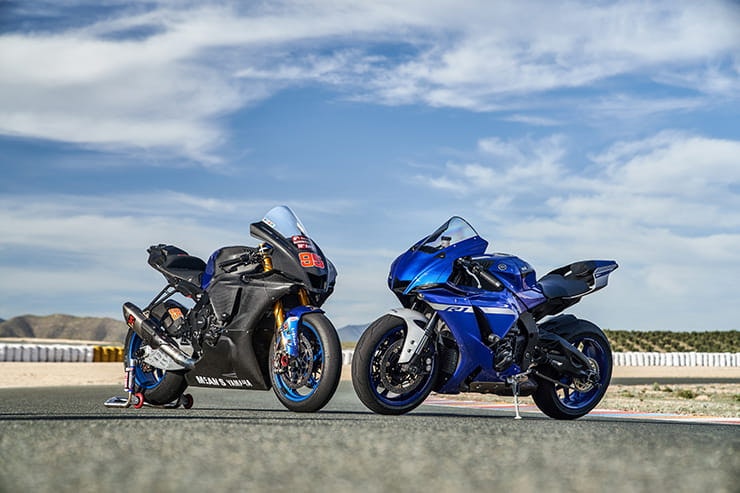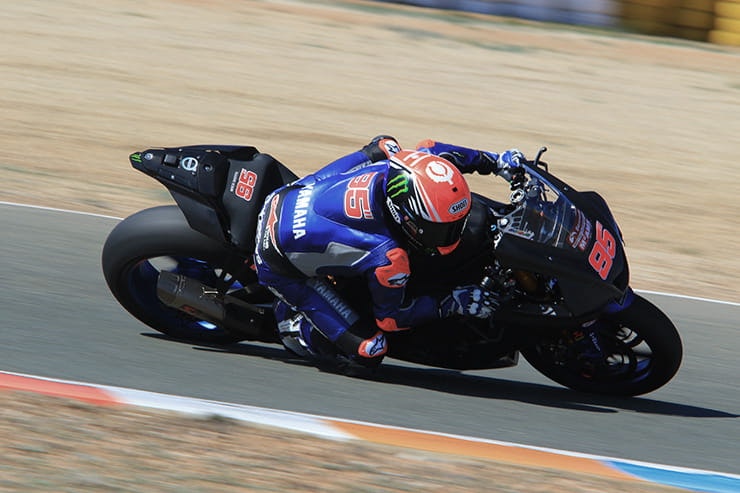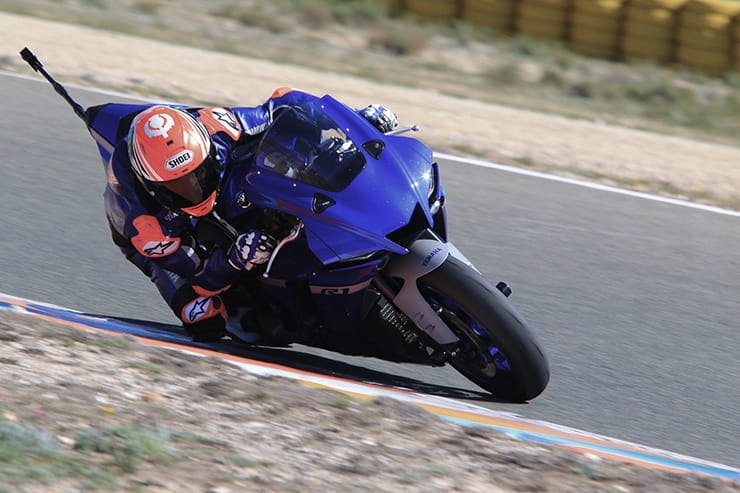How much quicker is a BSB race bike than the road version?
BikeSocial Road Tester
27.04.2020
The Bennetts British Superbike championship is regarded as the best domestic series in the world. One reason is the quality of its riders, with top talent like Leon Haslam, Jake Dixon and Scott Redding, to name just a recent few, sought after by international team managers.
A second reason is because the bikes are closely based on road-going production bikes. Engine-wise the cranks, pistons and rods must remain standard while the frame can’t be cut (though sections can be added). And a third reason is because, unlike in World Superbike, MotoGP and every top domestic series we can think of, most rider aids are banned. The bikes must run a control ECU, by MoTeC, and are devoid of traction control and anti-wheelie. Remember, these bikes make around 240bhp!
Ironically, in recent years the road bikes on which BSB bikes are based have not only increased their power outputs but have also significantly improved the sophistication of their electronic rider aids – none more so than Yamaha with their 2020 YZF-R1. The R1 uses technology derived from MotoGP; lessons learned by Valentino Rossi and his team are handed down for you to use on track days. Yamaha doesn’t use an ‘off-the-shelf’ kit from BOSCH, like many other manufacturers, instead their system is unique and bespoke to the R1.
The list of rider aids is mesmerising; lean-sensitive traction control, slide control, wheelie control, engine braking strategies, rider modes, cornering ABS, launch control, up-and-down quick-shifter. All of them can be tailored to how you ride, your tyre choice, the track and the conditions, which means that in many ways the road going R1 is far more advanced than its BSB racing sibling. Especially so when you consider the road bike must also be capable of taking you plus a pillion to the pub on a freezing night in winter.
With this advancement in electronics on road bikes, and close to 200bhp now the norm, we began to wonder... how much slower would a road-going R1 be than a British Superbike, which is essentially the same bike with even more power and improved handling but no rider aids?
With the same top-level racer on-board each, would the road bike be able to keep up with the race bike? What would the lap-time difference be? And could he perhaps even qualify a road R1 on to a BSB grid? Finally, and most intriguing of all, how much faster could any one of us ride if we were handed the hottest R1 in the UK for an afternoon?
Enter the hugely successful and experienced McAMS Yamaha race team. With their 2020 R1 BSB bike at our disposal, plus a standard R1 on OE tyres and settings, what could we expect?
Read our full track test review of the 2020 Yamaha YZF-R1 by clicking here.
Above: Taz looks concerned as an imposter 'warms' his seat
Track Test
Almeria, in southeast Spain, is the proving ground for many race bikes. Basking in glorious sunshine all year round, it’s a track day hub that attracts race teams and amateur riders throughout winter. The 4.3 km racetrack has 14 turns while the main straight just shy of 1km long – it’s the perfect venue to test both bikes.
We conducted the test in two ways. Firstly, I’d get to ride the stock R1 then the McAMS BSB bike, which would give me a sense of how each bike feels. But honestly, I’m not capable of pushing a BSB machine to anywhere near its limits; if I could I’d be a professional racer, so to set our recorded lap times we relied on our own version of The Stig, Tarran MacKenzie. Tarran (24) is the son of former GP rider and three times BSB champion, Niall and a former British Supersport champion and Moto 2 rider and has a BSB race win and four BSB podiums to his credit. Let’s race.
Turn 3, the long left-hander
It’s taken the road bike 26 seconds to get to the apex of turn three, the long left-hander with a late apex. Lots of people like this corner because it’s the first time in the lap you can really get the bike on its side. The road bike and race bike have similar apex speeds, 136kph compared to 140kph, so there isn’t much in it mid-corner, just 4kph. However, it only took the BSB bike 24 seconds to get to the same spot. We’ve completed just 2.5 corners, barely started the lap and already the race bike is 2 seconds in front. Apex speeds might be similar, but the race bike enters the corners faster, stops quicker, then fires out.
After riding both bikes, I can see why. The brakes are incredible on the racer. Into turn one you can brake later and deeper, and it’s the same into turn three. Here the differences between the two bikes are as obvious as Donald Trump's presidential imperfections. The road R1 is compliant, you can brake late and turn, rely on the cornering ABS, and once your toe slider starts to touch, that’s about the limit on its road rubber. But the BSB machine is on another level and wants to lean further, with more ground clearance and more grip generated by the chassis and Pirelli slicks, which means you can go deeper into the corner. For a rider of my capabilities, it feels alien. It wants to do so much more, but I don’t have the bravery, ball size or skill to help it.
Turn 7, the almost 90-degrees left-hander
Now we’re into the fast esses sections of the track. It’s taken the standard R1 44 seconds to reach this spot, right on the apex, the race bike 41.7 seconds. The McAMS race bike is still 2.3 seconds ahead, in racing terms a huge lead. Apex speed is again similar, 135kph against 137kph, which shows how good the road-going R1 is on standard settings. The gap hasn’t jumped up as dramatically as this section is much more flowing.
Into turn 7 the race bike feels more direct, lighter and easier to turn. The R1 is no heavyweight in comparison to other 1000cc road-going superbikes, but it feels sluggish in this company. However, the road bike does have an advantage: you can fall back on its electronics. I feel much safer on the approach and the exit and generally more at home on the road bike, whereas the BSB bike feels edgy and unknown, leaving me unsure of its intentions.
Between turns 7 and 8 there is a short blast of power before the next series of corners and the race bike hits 197kph, compared to 190kph on the road bike. Again, that isn’t bad for a street bike on standard gearing – especially so considering the racer is on bespoke Almeria gearing and using a completely different Nova gearbox and quick-shifter to standard.
Above: Taz, Chad and their varying styles
Between 9 – 11, over the rise in turn 10
Turn 9 is the left-hander out of the esses, turn 10 a fast left over a blind crest and into turn 11 the start of a tight chicane. It’s a tricky section of track, powering hard over that crest, but hugely satisfying. On the road-going R1 it takes 59 seconds to crest the rise, in third gear, just hitting 13,000rpm. It takes the BSB bike 56 seconds, and it is in fourth gear at 12,800rpm. Both bikes have clutches changes, but the race bike’s is obviously quicker and slicker.
The road bike is far easier to manage though, and again you can lean on those rider aids. The fuelling is excellent on the race bike, it’s not too aggressive from low down and the power is insane over the rise, with the brakes eye-poppingly powerful. Already the race bike is three seconds ahead, which is the difference between first and last in qualifying for some races.
Turn 14, the last before straight
Turns 11 and 12 make up the tight chicane, which is the slowest section of the track, and most riders hop the kerb. Turn 13 is a little awkward to get right, then into turn 14, the last turn before the long 900-metre straight. When the road bike arrives at turn 14, the gap has increased to 4.8 seconds.
This section is technical with fast direction changes and the BSB bike is way ahead. It weighs just 168kg, while the centre of gravity has moved lower with the fuel tank placed under the seat. Yes, the BSB is ‘easier’ to turn and manage, but at race pace you need to be an expert.
Onto the back straight and it’s second gear on the road bike. I just hit the power and let the anti-wheelie and traction control take over. The rider aids are so good you don’t feel them working. The race bike, meanwhile, needs more care. I don’t want to crash it and am unsure of the grip level available. However, surprisingly it doesn’t want to wheelie as much as I thought it would because the power is linear and smooth.
The main straight
On the road bike, Tarran hits 6th gear, 12,500rpm and 305kph, which is impressive, especially when you consider it’s on standard gearing. The aerodynamic bodywork is working perfectly, helped by a light, small rider. From the apex of turn 14 to its braking point at the end of the straight takes around 14 seconds.
The race bike’s terminal speed is higher at 327kph (203mph), and it takes 12.7 seconds to reach its braking point. On the straight alone, the race bike is gaining a second. The road bike feels quick, as you’d expect, but strangely the BSB didn’t seem that much faster as the power is so smooth, and it’s not trying to wheelie everywhere. I’ve ridden bikes with less power that feel faster because their power is aggressive, and the bike wants to constantly pivot around the back wheel.
But then… you approach the end of the straight, see the café at the end looming alarmingly quickly, and realise you’re flying – at 327kph to be precise. When you pop up from behind the new bodywork (with its aerodynamic wings to increase downforce), the feeling is incredible. The brakes combine with the fastest clutchless changes ever as we go from flat in top to second gear in less time than my brain can handle.
Over the start-finish
The McAMS race bike crosses the line with a time of 1m35.3, and the road bike 1m41.4, so that’s 6.1 seconds in it. Over the line, the racer was doing 254kph compared to 236kph. We can also compare average speeds over the whole lap, 158kph for the road bikes and 166kph for the race bike.
That is not bad for a road bike on road settings and standard rubber. If we had played around with the suspension and fitted slick tyres we would have seen that margin drop further, the McAMS team estimate to less than five seconds. Considering this is a bike you could ride out of the track and into the mountains, that is incredible. And its apex speeds were actually on a par with the BSB machine but as we’ve learned the BSB machine is all about raw power, much lighter weight and sublime brakes and grip.
But there is a flip side. In racing the difference between a road and race bike is huge but would Tarran be able to qualify the road bike in a BSB race? That’s touch and go.
There is a 107.5% rule in BSB, which means that if pole position was achieved with a lap time of 1.35.3, the cut off time would be 1.42 (rounding up). Therefore, Tarran would scrape inside the cut-off but would be last by some margin. Oulton Park in the UK has a similar lap time to Almeria (pole last year was a 1.34.950) and the slowest time was only four seconds behind than the pole time, not six. However, six seconds slower than a BSB machine would certainly qualify the road-going R1 into the top 30 of a Superstock grid, just, which is truly impressive.
Tarran Mackenzie on-board lap of Almeria | 2020 Yamaha YZF-R1
BSB racer takes the road bike for a lap before his race bike in an experiment to show the lap time difference
Does a faster bike makes for a faster lap time?
We know that Tarran is 6.2 seconds slower on the road bike compared to the McAMS BSB R1. And we know within a few corners the BSB R1 is already ahead by a few seconds. But to do that you must have the skill of a top-level BSB rider. Putting an average or even track-skilled rider on the race bike won’t mean they are automatically quicker, because you must have the techniques and determination to be able to push a bike a race bike to its limits. Which, like I said, I don’t have.
What about a road rider on the two bikes?
I’ve raced a little, mostly on the roads, but not for a few years. I was also worried about crashing the BSB R1 and only got a handful of laps to get used to it. Plus, I’m the wrong side of 40 and nearing 13-stone… plenty more than Tarran the athlete. There, excuses over with, but interestingly I set near-identical times on both the race bike and road bike at 1.50. Yes, my lap times were nearly equal. I couldn’t go any faster on the race bike and Tarran on the road-going R1 was 8.5 seconds faster.
Simply put, I don’t have the skill, bravery or fitness to make use of the BSB bike (and you won’t read that from many journalists). For me, the McAMS R1 was so much hard work; even though the power was smooth and it felt like a rocket ship. So, so fast. The force of the brakes nearly broke my wrists every time I applied them. Without traction control I was scared of high-siding, and I didn’t want to lose the front going into corners.
And all that lean angle felt alien. I’ve showed off and dragged my elbow for magazine pictures before but doing it at ‘race’ pace on a slick-shod BSB missile is another level. Just because I was on a faster bike didn’t mean I could automatically chop 5 or 6 seconds off my lap time. You have to be a professional like Tarran to be able to do that.
In contrast, I felt perfectly at home on the road bike, it is after all what I’m used to. I softened the power delivery via the rider modes, and even though I set the rider aids to minimum I knew they were there as a safety net, even the Corning ABS. The OE tyres had less grip but more feel; I could feel their limitations while I wasn’t able to slide the BSB slicks. On the road bike, you can sense the limit sooner, you don’t have to push as hard, which gives reassurance. It’s like rock climbing with ropes rather than free climbing, without any safety. Perhaps I could have gone quicker on the BSB bike if the fear of crashing and destroying it wasn’t an issue. The bike was set up for Tarran’s 50kg, not me. But at best 1.48 or 47, still way off even what Tarran can do on a road bike.
But even so, this small experiment shows that just because you have the latest, fastest superbike, doesn’t mean you’ll go faster. You still have to be a world-class rider to get the most out of a world-class bike.
Photography by Joe Dick and Axel Dowle


